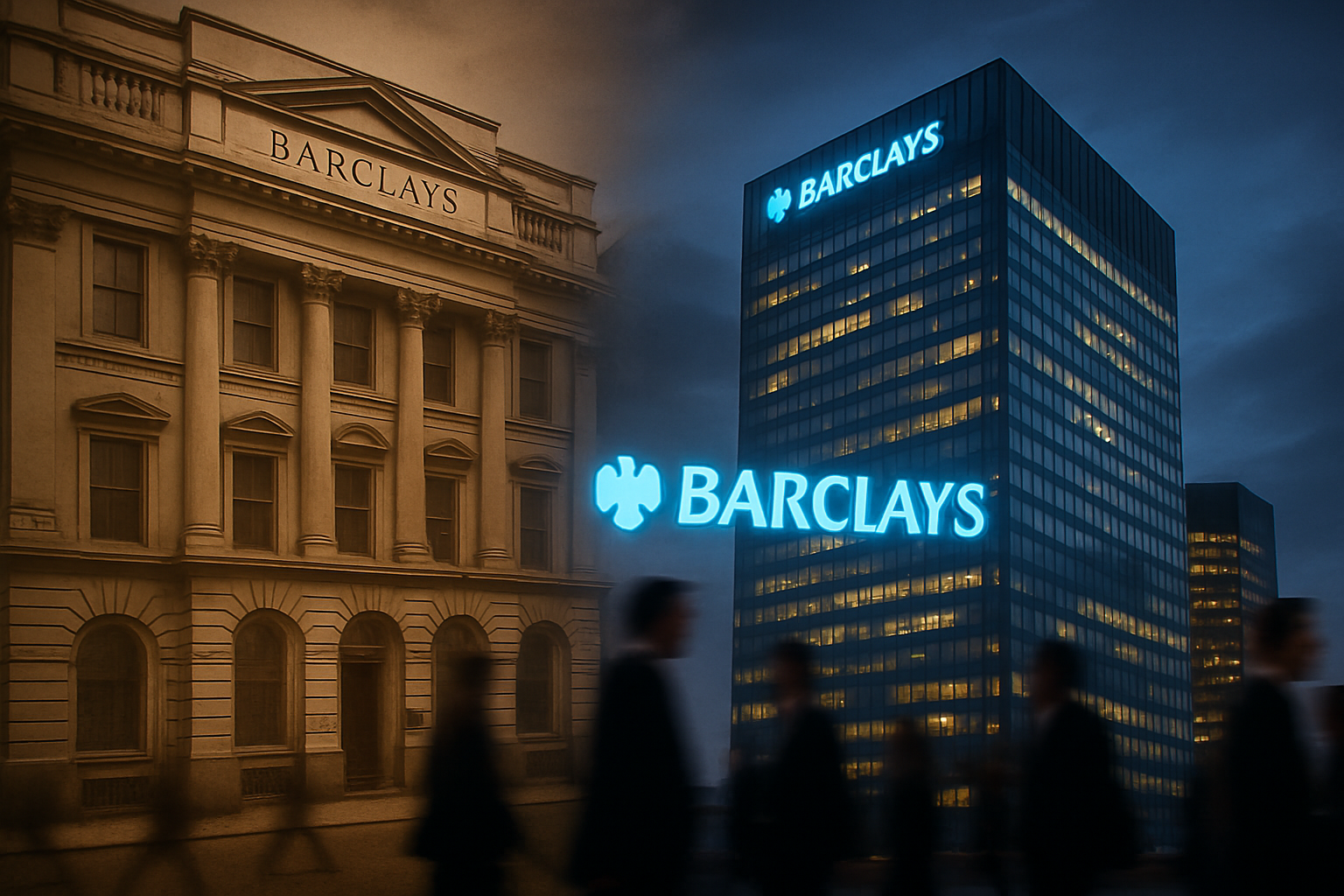History of Barclays PLC: From Quaker Roots to Global Banking Giant – Stock Overview (LSE:BARC)

Barclays PLC, one of the most influential financial institutions in the world today, traces its origins back over three centuries to the coffee houses and counting houses of London. From its modest beginnings as a Quaker-led partnership to becoming a pillar of international banking, Barclays has evolved through mergers, innovations, global expansions, and crises—each shaping the institution into the global powerhouse it is today. Listed on the London Stock Exchange as (LSE:BARC), Barclays' stock reflects not only its operational performance but also its storied legacy.
Humble Beginnings in 17th Century London
The origins of Barclays can be traced to 1690, when John Freame and Thomas Gould, both Quakers, began trading as goldsmith bankers in Lombard Street, London. Their business was rooted in trust, integrity, and simplicity—qualities deeply aligned with Quaker values. In 1736, James Barclay, Freame's son-in-law, joined the firm, marking the formal beginning of the Barclays name in British banking history.
In a time when trust and reputation were paramount, the Quaker association gave the firm a moral backbone and loyal clientele. This foundation would underpin the company’s development for generations to come.
Industrial Age Expansion and Innovation
Throughout the 19th century, Barclays expanded steadily, benefiting from Britain’s industrial revolution and a rising demand for formal banking services. The bank became known for pioneering financial products, including early deposit accounts and structured business lending.
One of Barclays' most significant milestones came in 1896, when it merged with 19 other banks to form a larger joint-stock bank under the Barclays name. This consolidation helped Barclays establish itself as a regional powerhouse and set the stage for national expansion.
By 1925, Barclays had become the first British bank to have a branch in continental Europe, opening in Paris. This early foray into international banking demonstrated a visionary approach that few peers had embraced.
Technological Leadership in the 20th Century
Barclays was consistently ahead of its time in adopting new technologies to improve banking services. In 1967, it launched the world’s first Automated Teller Machine (ATM) in Enfield, North London—a move that revolutionized consumer banking and positioned Barclays as a leader in retail innovation.
Throughout the latter half of the 20th century, the bank continued its technological evolution. Barclays was one of the first British banks to implement computerization and electronic recordkeeping, driving operational efficiencies and scalability.
At the same time, the bank's acquisition strategy picked up pace. In 1986, Barclays acquired American bank Wells Fargo's UK business, giving it further foothold in the increasingly competitive British market. This move also marked the beginning of its greater focus on investment banking.
Globalization and the Rise of Barclays Capital
The late 20th and early 21st centuries marked Barclays’ transformation into a truly global player. A key milestone came in 1997 with the creation of Barclays Capital, its investment banking arm. With this move, Barclays began directly challenging Wall Street’s elite players.
Its strategic ambition became even more apparent in 2008 when Barclays acquired the North American operations of Lehman Brothers in the wake of the global financial crisis. This acquisition gave Barclays a powerful presence in U.S. capital markets and helped it gain instant scale in investment banking.
Barclays' expansion into the United States was seen as one of the most opportunistic moves of the post-crisis era. At a time when many banks were retreating, Barclays pushed forward, building out services in equity and fixed-income trading, mergers and acquisitions advisory, and asset management.
Post-Crisis Reforms and Regulatory Challenges
While the Lehman acquisition was a strategic victory, the years that followed were fraught with challenges. Barclays, like many global banks, faced heavy scrutiny from regulators in both the UK and U.S. As regulators imposed stricter capital requirements and demanded better risk controls, Barclays was forced to reevaluate its global strategy.
In 2012, Barclays was fined for manipulating the London Interbank Offered Rate (LIBOR), resulting in a leadership shake-up and reputational damage. This marked a turning point for the company, which then embarked on a mission to rebuild trust and shift focus from aggressive growth to compliance and sustainability.
The years that followed involved significant restructuring. Barclays exited several non-core markets, scaled down its African operations, and consolidated its UK retail and corporate business under the brand “Barclays UK,” while keeping investment and international banking under “Barclays International.”
Modern Barclays: Strategy and Digital Transformation
Today, Barclays operates in over 40 countries and serves more than 48 million customers worldwide. The bank’s operations are split into two major divisions: Barclays UK and Barclays International. These segments focus on personal and business banking, credit cards, investment banking, and wealth management.
In recent years, Barclays has heavily invested in digital transformation. The launch of the “Barclays Mobile Banking” app and AI-powered fraud detection tools have positioned it at the forefront of tech-enabled banking. The institution has also invested in fintech partnerships and has launched innovation labs in London and New York.
Sustainability has also taken center stage. Barclays has committed to becoming net zero by 2050 and has reduced financing to fossil fuel-related projects, reflecting growing investor and societal pressure.
Stock Performance and Investor Outlook
(LSE:BARC) remains one of the most widely traded banking stocks in the FTSE 100 index. Despite the turbulence of past decades—including the global financial crisis, Brexit, and the COVID-19 pandemic—Barclays has maintained solid capital buffers, consistent dividends, and robust operating margins.
Analysts often view Barclays as a bellwether for the UK financial sector. Its global diversification has helped shield the company from localized economic shocks, although it remains exposed to regulatory risks and macroeconomic cycles.
For long-term investors, Barclays offers a mix of value and yield. It trades at a discount to many global peers, partly due to past scandals, but recent governance improvements and digital investments have reignited confidence among institutional investors.
Barclays in the Context of Global Banking
Barclays competes with other global institutions such as JPMorgan Chase (NYSE: JPM), HSBC Holdings (LSE:HSBA), and Deutsche Bank (ETR:DBK). Its diversified model—combining strong UK retail operations with a leading investment bank—sets it apart from banks that focus solely on one side of the business.
In an era of digital disruption and rising ESG expectations, Barclays’ ability to adapt could determine whether it remains a leading force in global finance or risks falling behind more nimble fintech-driven competitors.
Conclusion
From its Quaker roots in 17th century London to its current status as a multinational financial giant, Barclays PLC has weathered wars, financial crises, scandals, and revolutions in technology. As it enters its next chapter, the bank’s legacy of innovation, resilience, and reinvention continues to shape its future.
The journey of (LSE:BARC) serves as a case study in how institutions can endure and evolve through centuries—grounded in history, yet focused on tomorrow.
Disclaimer: This article is for informational purposes only and does not constitute financial advice, investment recommendation, or an offer to buy or sell any securities. Investors should conduct their own due diligence or consult a professional advisor before making investment decisions.
More News
View More




Recent Quotes
View More
Quotes delayed at least 20 minutes.
By accessing this page, you agree to the Privacy Policy and Terms Of Service.